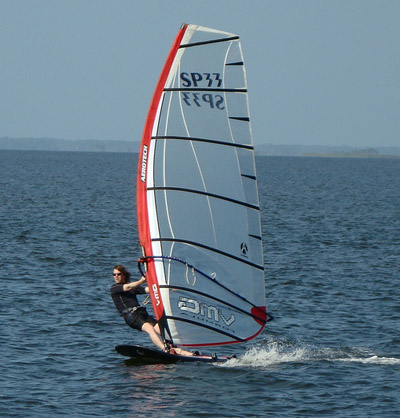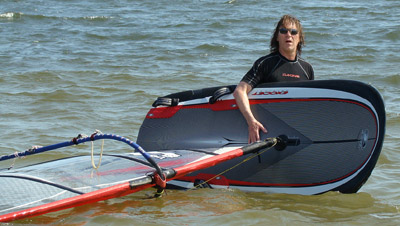| Windsurfing
at Shell Point Beach, Florida 
Shell Point Beach is the sailing spot of choice for members of the Shell
Point Sailboard Club. Shell Point is about 45 minutes south of Tallahassee,
Florida, and is located on the northern edge of Apalachee Bay (see
map ). Although the beach was previously under private ownership,
members of the SPSC and local activists of Wakulla County petitioned the
State of Florida for grant money to purchase the beach, fearing loss of
access due to condominium development. Grant monies were awarded to Wakulla
County in December, 1995, and Shell Point Beach is now managed by the
Wakulla County Parks and Recreation Department. Beach facilities are limited;
however, the SPSC provides water, drying racks, and sailing camaraderie
to its members and  visiting
sailors. visiting
sailors.
Wind Conditions
During the winter months, winds are frontal related, with warm southwest
winds preceding cold fronts, and colder northwest winds behind the fronts.
These frontal passages often bring winds ranging from 25-30 knots. During
the late spring and early summer, southwest sea breezes can develop in
the afternoon, and wind speeds of 15-25 knots are possible. Current wind
conditions at Shell Point are available by calling Windy the Windtalker
at (850) 926-8802.
Water Conditions

During the winter, surface water temperatures in the shallow bay are in
the neighborhood of 50-60 fahrenheit, and depending on the air temperatures
(35-75 fahrenheit), sailors wear either a drysuit or a wetsuit. During
the spring and fall, shorties are worn, while in the summer, cutoffs and
speedos are de riguer. A boat channel rings the beach, and offers access
to the deeper waters of the bay. Sailors are encouraged to respect all
boat traffic, and generally will cede right of way to avoid conflicts
with other boaters. Outside the channel, shallow sand and grass flats
are ankle to chest-deep, depending on the tide conditions, which fluctuate
as much as four feet. Outside the flats, small waves (2-4 feet) can be
enjoyed in 8-20 feet of water. Oyster bars are prevalent in the adjacent
Oyster Bay area, and can be a hazard when sailing southeast or northwest
winds. Although clearly visible at low tide, they can easily ruin a fin,
a foot, or worse, and it is advisable to sail these winds cautiously until
you learn the area.
|


 visiting
sailors.
visiting
sailors. 